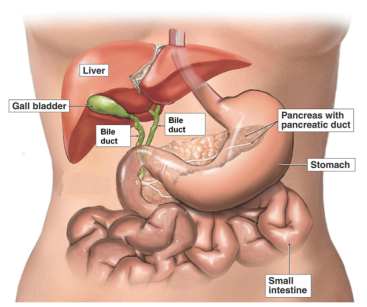Bile duct cancer (cholangiocarcinoma)
Bile duct cancer is also called cholangiocarcinoma (CCA). It affects almost 200* people in Ireland each year. Most bile duct cancers occur in people over the age of 65.
Signs and symptoms
Learn about the signs and symptoms of bile duct cancer. You are more likely to survive cancer if you find it at an earlier stage.
Treatments
There are a number of different treatments available for bile duct cancer. Your medical team will explain the best treatment options for you.
What is bile duct cancer?
Bile duct cancer is a primary liver cancer. When cancer develops in a bile duct, the cells change and grow in an abnormal way. As the cancer grows it forms a collection of cells (tumour). This tumour can cause a blockage and cause symptoms, such as jaundice (when your skin turns yellow).
Bile duct cancer is also known as cholangiocarcinoma (“co–langee-oh car-sin-oh-ma”) or biliary tract carcinoma.
Bile duct cancer is a rare cancer. About 200 people are diagnosed with bile duct cancer in Ireland every year. It usually affects people over the age of 65.*
Most bile duct cancers are a type called adenocarcinoma.
What are the types of bile duct cancer?
There are three main types of bile duct cancer (cholangiocarcinoma), depending on the part of the bile duct the cancer starts in:
- Intrahepatic bile duct cancer – starts in the hepatic bile ducts in the liver
- Perihilar bile duct cancer – starts outside the liver, near where the left and right hepatic ducts meet
- Distal extrahepatic bile duct cancer – starts in the common bile duct outside the liver
Most bile duct cancers start in the epithelial cells which line the bile ducts. This cancer is called epithelial adenocarcinoma.
What are the bile ducts and what do they do?
The bile ducts are part of the digestive system. They are tubes that connect your liver and gallbladder to your small bowel. The gallbladder is a small organ that lies just under the liver. The ducts carry fluid called bile. Bile is made by your liver and stored in your gallbladder. The bile ducts carry bile from the gallbladder to your small bowel, where it helps to break down fat during digestion.

There are different ducts:
Bile ducts coming from your liver. These are divided into left and right hepatic ducts. The left and right ducts join just outside the liver to form the common hepatic duct.
Bile duct coming from the gall bladder. It joins the common hepatic duct to form the common bile duct.
Bile duct coming from the pancreas – this joins up with the common bile duct.
All the ducts join up and release bile into the small bowel to help digest the food we eat.
What increases my risk of bile duct cancer?
The cause of bile duct cancer is unknown. But there are certain things called risk factors that can increase your chance of developing the disease. These include:
You might have an increased risk if you have ulcerative colitis, Crohn’s disease or other inflammatory bowel disease.
A rare condition that causes chronic inflammation and scarring of the bile ducts.
Stones in the bile duct can cause inflammation.
If you are born with abnormal bile ducts, you might be at risk of developing cancer of the bile duct.
These cysts attach to the bile ducts and can lead to cancer developing.
Bile duct cancer has been linked to Hepatitis B and C virus infection. In Africa and Asia, an infection caused by parasites called liver fluke is believed to cause bile duct cancer.
Cirrhosis (scarring of the liver) can increase risk. There are many different causes of cirrhosis such as hepatitis B and C, fatty liver disease or alcohol-related liver disease.
Having a risk factor doesn’t mean you will get cancer. Sometimes people with no risk factors get cancer. If you’re worried, talk to your GP or talk to one of our cancer nurses. Call our Support Line on 1800 200 700 or visit a Daffodil Centre.
Medical content reviewed by A McGuire, Advanced Nurse Practitioner Hepaticopancreaticobiliary Surgical Oncology (2022).
Talk to a Cancer Nurse

Support Line
Our Daffodil Centres

*The Irish Cancer Society uses the most up-to-date cancer statistics from the National Cancer Registry Ireland, available on www.ncri.ie
